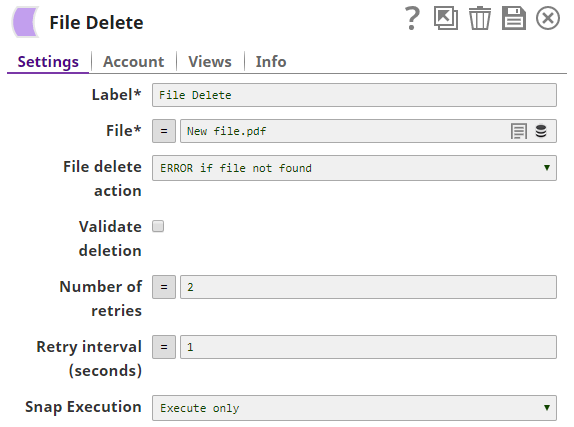On In this Pagearticle
| Table of Contents | ||||
|---|---|---|---|---|
|
Snap type:
Write
Description:
Overview
You can use this Snap to delete a file in the SLDB, S3, FTP, SFTP, FTPS, WASB, WASBS, GS, and SMB protocols.
Snap Type
File Delete Snap is a WRITE-type Snap.
Prerequisites
Valid client ID.
A valid account with the required permissions.
None.
Support for Ultra Pipelines
Works in Ultra Task Pipelines.
Limitations and Known Issues
None.
Snap Views
| Type | Format | Number of Views | Examples of Upstream and Downstream Snaps | Description |
|---|---|---|---|---|
Input | Document |
|
| The Snap expects to find values for the JSON paths used in the File property, if any. |
Output | Document |
|
| The file name and the delete status are written to the output view. The following example shows the output document map data:
|
None.
This Snap supports a Basic auth account, an AWS S3 auth account, SSH Auth account, SMB account, or no account. See Configuring Binary Accounts for information on setting up accounts that work with this Snap.
| Input | This Snap has at most one document input view in which it might obtain values for the evaluation of the JavaScript expression in the File property. |
|---|---|
| Output | This Snap has at most one document output view. |
| Error | This Snap has at most one document error view and produces zero or more documents in the view. |
Settings
Label
File
| Error | Error handling is a generic way to handle errors without losing data or failing the Snap execution. You can handle the errors that the Snap might encounter while running the Pipeline by choosing one of the following options from the When errors occur list under the Views tab. The available options are:
Learn more about Error handling in Pipelines. | |||
Snap Settings
| Info |
|---|
|
Default value: [None]
Field Name | Field Type | Description | ||
|---|---|---|---|---|
Label* Default Value: File Delete | String | Specify a unique name for the Snap. | ||
File* Default value: [None] | String/Expression | Specify the URL for the file to be deleted. It might start with a file protocol. The supported file protocols are SLDB, S3, FTP, SFTP, FTPS, WASB, WASBS, GS, and SMB protocols. | ||
sldb:///usr/john/json_files/accounts.json
| |||||||||||||||
| File delete action | |||||||||||||||
Default value: ERROR if file not found Example: IGNORE if file not found | Dropdown list | Specify the action that the Snap must take when the target file is not found during a file delete attempt. Select from the following options:
| ||
Validate deletion Default value: | ||||
Validate deletion
If selected, the Snap checks SpecifiesNot selected | Checkbox | Select this check box to enable the Snap to check if the deleted file still exists. | ||
Number of retries Default value: | ||||
0 | Integer/Expression | Specify the maximum number of retry attempts in case of a network failure.
| ||||
Retry interval (seconds) Default value: | ||||||
1 |
| Integer/Expression | Specify the minimum number of seconds for which the Snap must wait before attempting recovery from a network failure. Minimum | |
value: 1 |
Example: 3
| Advanced properties | Use this field set to define additional advanced properties. | |||
| |||
| |||
| Dropdown list |
| |||||||||
Values | String/Expression | ||
Snap Execution | |||
Default Value: Execute only | Dropdown list |
| ||||||||
Example: Validate &
| |||
Example
Deleting a File from Your SnapLogic Database
The following pipeline describes a File Delete Snap that deletes a file from your SnapLogic database. The pipeline:
- Reads a file from your SnapLogic database using the File Reader Snap.
- Writes/Creates a new file in your SnapLogic database using the File Writer Snap.
- Passes the filename field to the File field of the File Delete Snap using the Mapper Snap.
- Deletes the newly created file, using the filename parameter, from your SnapLogic database using the File Delete Snap:
Similarly, in the above example, you can directly pass the filename in the File field of the File Delete Snap:
The following File Delete Snap deletes a file that exists on an external server. You must link the File Delete Snap with a valid user account and ensure that the user account has the appropriate privileges to delete a file from an external server. In the following pipeline, the File Delete Snap uses valid FTP user account credentials to delete the test.csv file:
| Insert excerpt | ||||||
|---|---|---|---|---|---|---|
|



